Hungry Ghosts: a long posting, with pix!
This is the seventh lunar month, according to the Chinese calendar. It’s the time of year when the ghosts are out of hell on furlough.
If you’re a Buddhist, this month is devoted to filial piety; you honor your parents and ancestors, pray that they are in a better reincarnation, if they didn’t manage to attain Nirvana, and at the end of your prayer services you dedicate any excess merit to those souls who need it to improve their karma. Pretty simple, eh?
Not so if you’re a Taoist; this is the month when you need to feed and appease the Hungry Ghosts. Keep them happy and they’ll go back where they belong, without giving you bad luck or diseases. Hungry ghosts are the spirits of those unfortunate people who don’t have descendants feeding them on a regular basis by offering their name-tablets incense, oranges, and ghost money on a regular basis. (Most Chinese families have a shrine in the home where they do this for their ancestors.) You might become a hungry ghost if you die far from home, or without children – or in a case I heard of yesterday, if your children all convert to Christianity and simply refuse to do the proper rituals for you.
Lots of temples and various Chinese associations band together to do feasts for the hungry ghosts, along with puppet shows, songs and dancing or even Chinese opera on a stage, with a row of empty seats in the front, for the invisible guests of honor. We went to a smaller ritual put together by the people in a couple of HDBs near Chinatown, which took the better part of an afternoon. They had a spirit medium, a feast for the ghosts (and refreshments for the humans), food bags for their membership and for the poor, and a grand bonfire of ghost money and paper offerings to finish it all off. The people were very kind and welcoming to us, and apparently happy to share their activities. Our daughter got to fold some ghost money into ingot-shapes for burning – a good use for her interest in origami. Pictures and my attempts to understand follow:
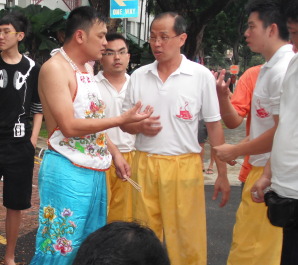
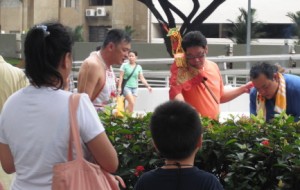 The man with the bare shoulders is the Taoist spirit medium. The deity he channels is a child, so he wears a traditional frontal apron and brightly-colored pants, which I guess children used to wear. If you click on the photo to enlarge it, you might be able to see the pendants on the chain around his neck: pacifiers! When we arrived he was already in a trance state, telling people how to arrange the altars and what procedures to follow. The men in yellow pants seem to be his official helpers or acolytes; I’m not sure exactly what their connection to the event is. On the right, they’re setting up a small altar adjacent to the street; I think this was to welcome any passing spirits who might have been in the neighborhood. At one point the medium tossed lighted incense sticks into the street, the better to waft their scent to the spirits.
The man with the bare shoulders is the Taoist spirit medium. The deity he channels is a child, so he wears a traditional frontal apron and brightly-colored pants, which I guess children used to wear. If you click on the photo to enlarge it, you might be able to see the pendants on the chain around his neck: pacifiers! When we arrived he was already in a trance state, telling people how to arrange the altars and what procedures to follow. The men in yellow pants seem to be his official helpers or acolytes; I’m not sure exactly what their connection to the event is. On the right, they’re setting up a small altar adjacent to the street; I think this was to welcome any passing spirits who might have been in the neighborhood. At one point the medium tossed lighted incense sticks into the street, the better to waft their scent to the spirits.
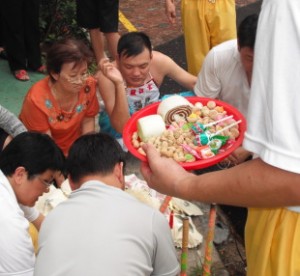 The medium guided everyone in building up this pile of offerings in the right way: nicely displayed paper, food offerings, candles, etc.
The medium guided everyone in building up this pile of offerings in the right way: nicely displayed paper, food offerings, candles, etc. 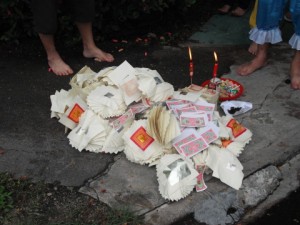 Once it was arranged to his satisfaction, he led the lighting of joss sticks and offering these goodies to the street-side ghosts, inviting them into the HDB complex for the actual feast. Or at least that’s what I think was going on.
Once it was arranged to his satisfaction, he led the lighting of joss sticks and offering these goodies to the street-side ghosts, inviting them into the HDB complex for the actual feast. Or at least that’s what I think was going on.
Here they’re offering incense towards the wandering street ghosts: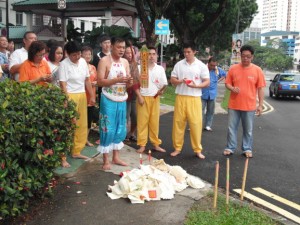
Once they invited the ghosts in, they made a procession around the feast they’d laid out for the ghosts, as well as the bags of food they’d prepared for the poor and the association members, for distribution at the end of the ritual. This food is interesting: it used to be that the association members would bring actual food to feed the ghosts, and distribute the leftovers to the poor at the end of the ritual. But now that Singapore is more prosperous, nobody needs to eat food that’s been sitting around for a few hours. So each association member contributes $50 towards the ritual. The money goes to buy all the supplies of ghost money, incense, etc. and a lot of food – bags of rice, soy sauce, instant coffee, and other goodies. The cooks in the association prepare yummy dishes for the ghosts, and a few snacks for the participants. But most of the money goes for big food bags: each year one third of the members receive a bag, and the rest go to feed the poor.
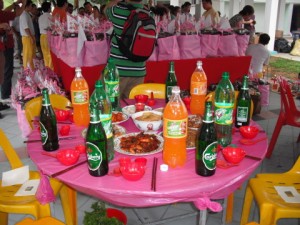
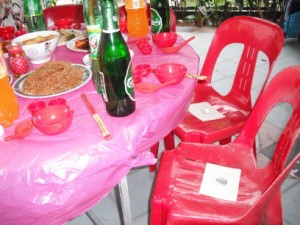 Here’s the ghost feast: beer, soda, shrimp, noodles, soup, and other yummy things. The bottles were all open, presumably because the ghosts can’t handle twistcaps. But evidently they CAN handle chopsticks. The chairs have ghost placeholders on them. I was told that silver on the papers means they’re for wandering spirits; gold foil on the papers means they’re for family. Color-coded seating chart!
Here’s the ghost feast: beer, soda, shrimp, noodles, soup, and other yummy things. The bottles were all open, presumably because the ghosts can’t handle twistcaps. But evidently they CAN handle chopsticks. The chairs have ghost placeholders on them. I was told that silver on the papers means they’re for wandering spirits; gold foil on the papers means they’re for family. Color-coded seating chart!
There were also small bathrooms set up for male and female ghosts; I didn’t get a picture of them, because they were mostly veiled with tatami mats. Ghosts like their privacy, evidently. The tatami mats were upended and coiled into screens around stools. Each stool had a plastic basin on it, and in each basin was a paper representation of high-end toiletries. Outside each tatami screen was a large plastic bucket filled with water. The ghosts don’t get running water, but that doesn’t mean they can’t wash before eating.
The worshippers followed the medium in a trail through the communal part of the HDB complex, inviting the spirits to partake of the two ghost banquet tables, the ghost bathrooms, the food bags for association members and charity, the altar (below) and two mats with paper offerings on them. The offerings were for all manner of spirits: male, female, adult and young. Here’s one set, with piles of money in front, paper shoes, games, toys and jewelry. The mat next to it contained playing cards, a paper mahjong set, a paper opium set, and open packs of cigarettes.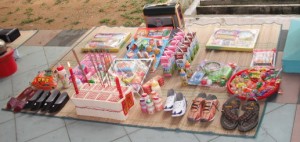 All these nice things are meant to be burned after the feast, so the ghosts can wear jewelry and shoes and play games in the afterlife. And get stoned on opium as well.
All these nice things are meant to be burned after the feast, so the ghosts can wear jewelry and shoes and play games in the afterlife. And get stoned on opium as well.
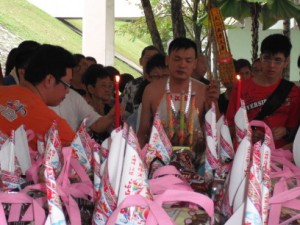
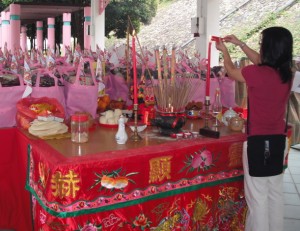 The medium is on the left, blessing the altar at the feast – or maybe invoking the spirits there. At any rate, once he had finished leading the procession through the feast and to the altar, he disappeared from the proceedings. The altar itself is on the right. Click on it to see its contents more clearly. Soy sauce, dumplings, ghost money and a few other things.
The medium is on the left, blessing the altar at the feast – or maybe invoking the spirits there. At any rate, once he had finished leading the procession through the feast and to the altar, he disappeared from the proceedings. The altar itself is on the right. Click on it to see its contents more clearly. Soy sauce, dumplings, ghost money and a few other things.
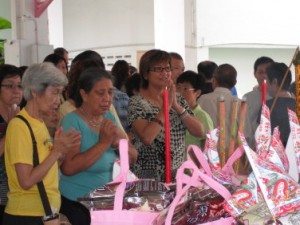
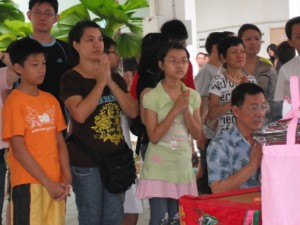 Once the medium left, everyone could take turns worshipping at the altar, and hoping to intercede for their families. I found this part of the proceedings quite moving; after all the smoke and fuss and preparation, this is really about people missing their loved ones. The family on the right is a group of people who’d caught my eye during the procession, especially the daughter.
Once the medium left, everyone could take turns worshipping at the altar, and hoping to intercede for their families. I found this part of the proceedings quite moving; after all the smoke and fuss and preparation, this is really about people missing their loved ones. The family on the right is a group of people who’d caught my eye during the procession, especially the daughter.
Once the ghosts had eaten their fill, all the paper goods and money were to be burned in a huge iron cage. While the worshippers ate their snack and folded ghost money, a group of men stacked bricks of ghost money into the cage in a bonfire shape, kind of like a kiln with plenty of space for air to circulate. We didn’t stick around for the fire, as we were already pretty well smoke-cured ourselves with all the candles and incense.
December 22nd, 2009 at 3:23 am
[…] come for a tour of its spooky side, try to arrange for travel during the 7th lunar month for the Hungry Ghost festival. If you’re not looking for ghosts, however, there are still a couple of things to be aware […]